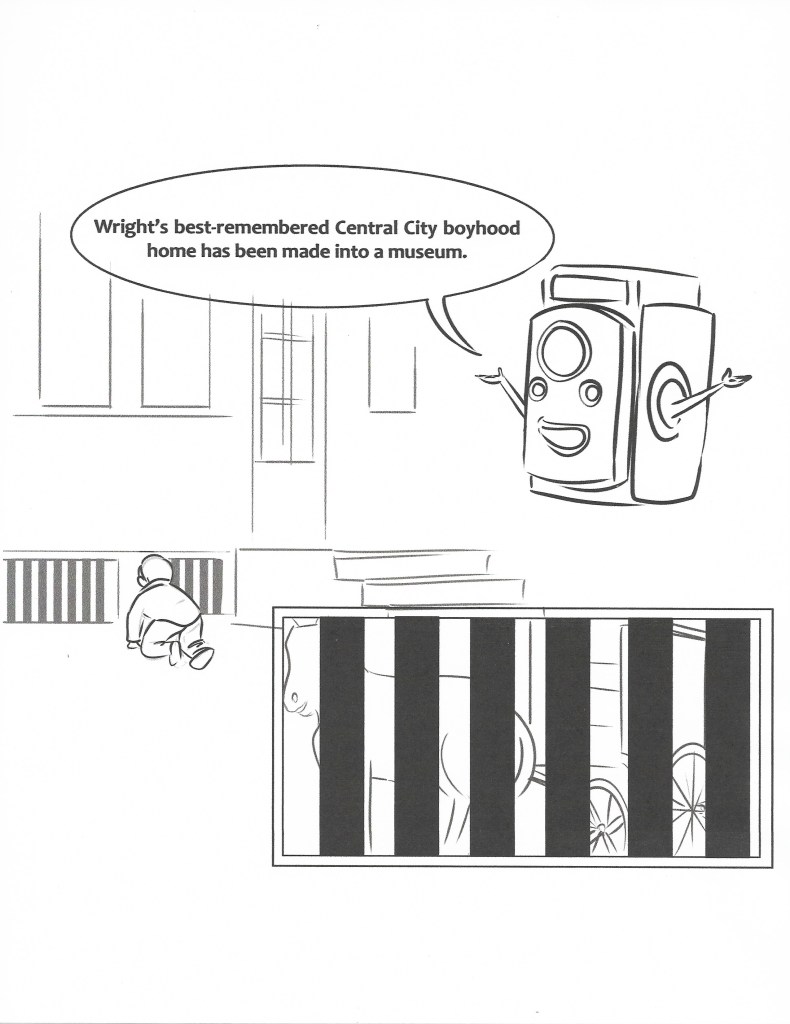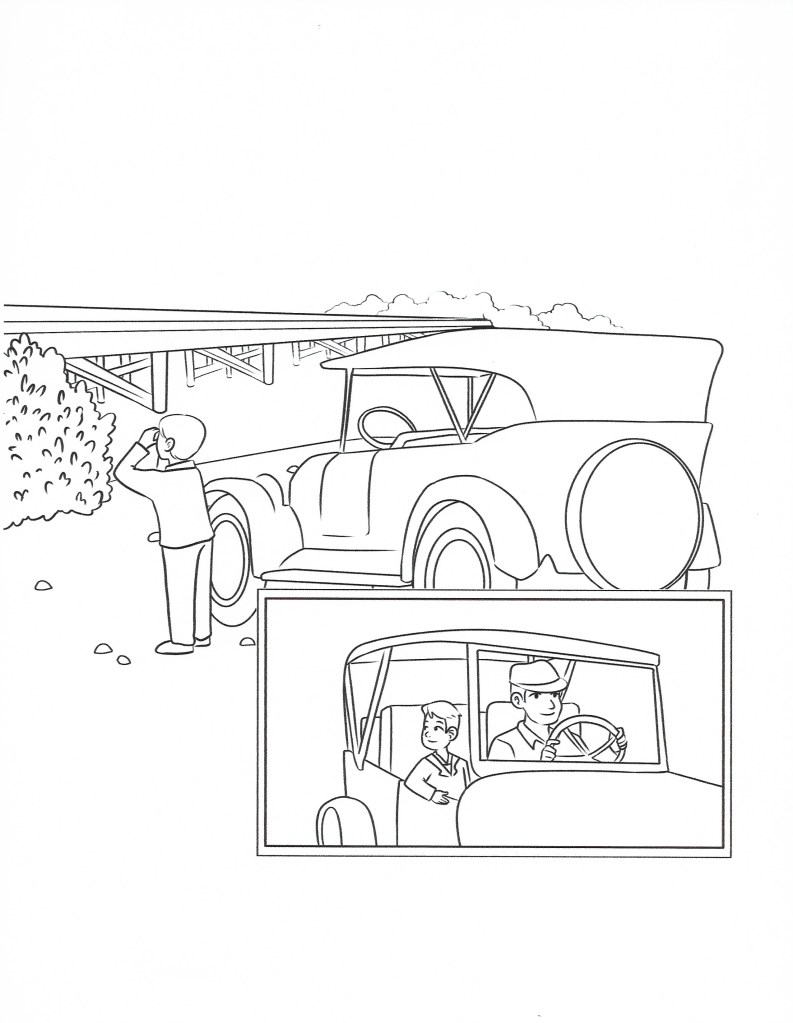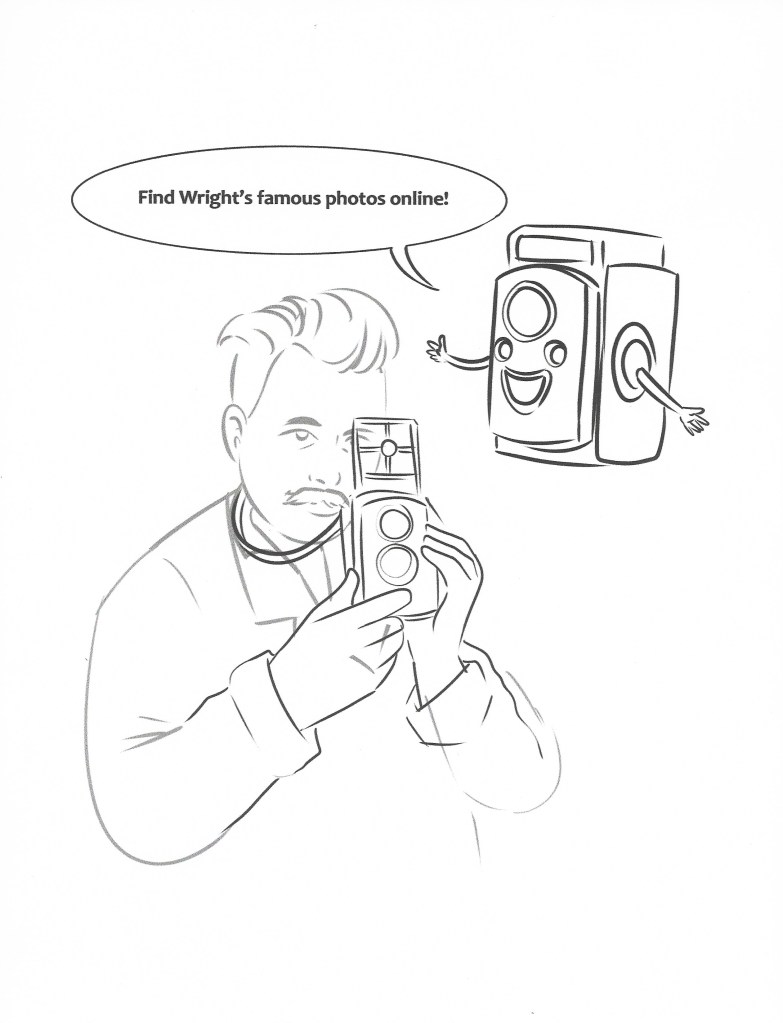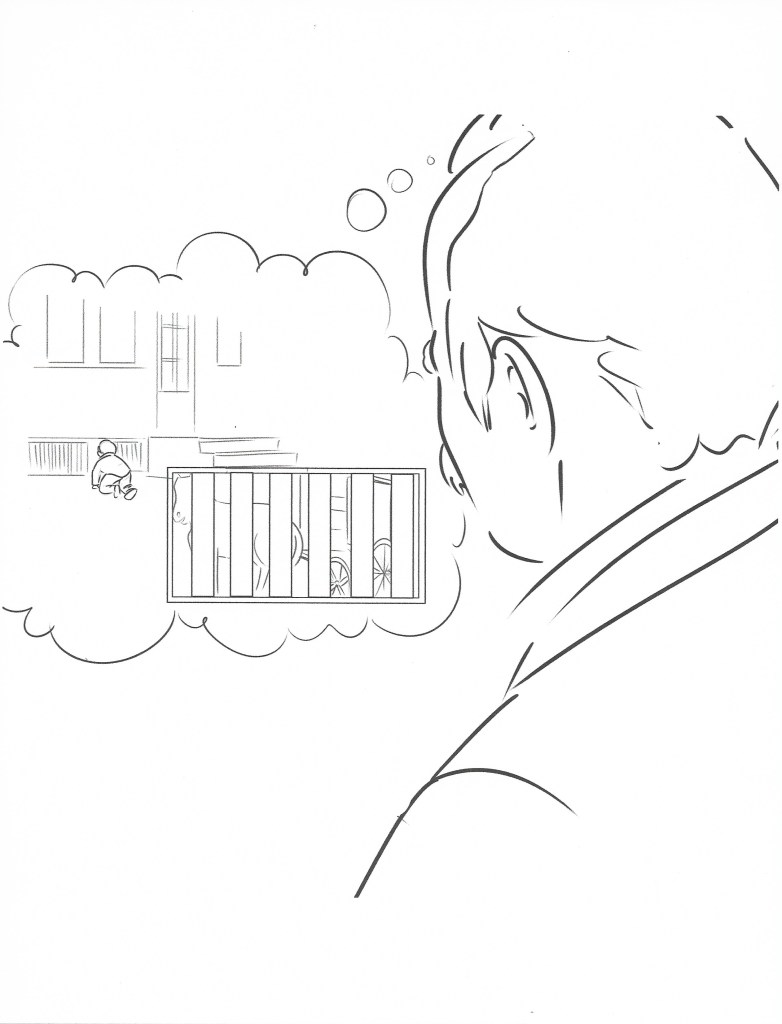Little by little, I will be adding pages which may be used with some of my books.
This section will include activities and coloring pages for Wright: Biography of the Boy from Central City.
I was just surprised by my illustrator with a coloring book cover! So, if you want to assemble a book of coloring pages, here is a cover! Big thanks to 1000 Storybooks staff! (Otherwise, you can just pick the individual pages you want to use.)

Activity Page 1/13

Note:
Choose an activity page. With a right click, choose “Copy Image” and paste your image to a new page blank. You may adjust the size of the image. Then send it to print for as many copies as you wish.
Here are some discussion topics for the illustration above:
Families: Who had the bigger family? Will? Or Grace? How does your at-home family compare in size to Will’s family? Larger? Or smaller? Grace had three sisters. How many do you have? If you are in a group, can you make a sticky note graph to show any of this information? Author’s Note: The sketch of Grace on the lower right of this page was made from a real photo of Wright’s mother, Grace Osborn Morris.
Calling Cards: Calling cards were an early form of social media. They came before business cards and way before online social sites. They were like a text on a little piece of cardboard! Rollei’s card has its upper right corner folded over. That means he is leaving his card “in person” and his message is for everyone. Find out more about calling cards online, design your own calling card, and make copies using a business card or postcard template.
Barber’s Poles: You see a barber’s pole on this page. For many years, these were a sign for a barber shop. Can you find some barbershop songs online? Or. Ask a music teacher about barbershop songs?
Your turn: Make up a question or an activity of your own for this page!
Note:
Choose an activity page. With a right click, choose “Copy Image” and paste your image to a new page blank. You may adjust the size of the image. Then send it to print for as many copies as you wish.
Activity Page 2/13

Author’s Note: I was sorry to discover that Wright’s older brother died. but that was a fact in his parent’s and Wright’s life. It was something to know about and carry in their hearts through their life journeys. I thought you, as readers of Wright’s history, would like to know.
Birth Announcements:
Did you have a birth announcement when you were born? Ask about it. See how it compares to Wright’s birth announcement.
Birth Order:
Wright was the second baby born to his parents. What was your birth order number? Ask your parents/grandparents about their birth order numbers. They will probably have some great stories to tell you. Write down your favorite stories.
How You Got Your Name:
Wright’s full name was Wright Marion Morris. Parents often name their children after family members or close friends. Is there a story behind the name you were given?
Your turn: Make up a question or an activity of your own for this page!
Activity Page 3/13

Author’s Note:
Another sad fact was added to Wright’s life story when his mother died shortly after he was born. Wright’s caretaker, Anna, a friend of Grace and her sisters, lived in Aurora, NE. Anna rode a north-south Burlington train to Central City on the days she was taking care of Wright, while his father, Will Morris, was working at the east-west Union Pacific depot.
Will’s Boy:
As an adult, Wright wrote a book called Will’s Boy. Ask a librarian or media specialist to help you find an old copy so you can see the picture of a very young Wright looking into a birdcage (opposite the title page). This is a rare photo of Wright as a child.
“Distant” Relatives:
Wright had relatives (his mother’s family) that he did not meet until he was adult age. Are you related to anyone that you would like to meet with someday? Note: You can time travel to past or future if you like! Write about it!
Your turn: Make up a question or an activity of your own for this page!
Activity Page 4/13

Author’s Note:
Wright’s father, Will, wanted to raise chickens for profit just before the family left Central City; however, the chickens got sick and died. Will had recently married a new, young wife, Gertrude, who was from Omaha. When the chicken venture failed, Will was persuaded to move to Omaha with Gertrude and Wright.
Chicken Memories:
Wright Morris’s photographs are archived at the Center for Creative Photography in Arizona (ccp.arizona.edu). If you look there in the Morris collection or in a book of Wright’s photographs, can you find some reminders of those chicken-raising days in Central City?
Acrostic Chicken Poem:
Making the letters for the word chicken vertically along the left side of your paper/screen, think of a word beginning with “C” that describes a chicken. Then move down to the next line and think of a word that describes a chicken beginning with “H”. Only five more letters to go, and you will have a finished acrostic poem about a chicken!
Your turn: Make up a question or an activity of your own for this page!
Activity Page 5/13

Author’s Note:
If you can visit Central City, NE, you can find Wright Morris’s boyhood home at 304 D Street.
WWYD?
Would you have followed Wright under his porch to observe his neighborhood by peering through the porch slats? Write about why you would or would not have followed Wright through that little door on a colored sticky note. If you are in a group, see if you can create a graph with the sticky notes.
Focus Frames:
Try creating a set of three focus frames through which you can view your world. Make the frames from a half sheet of black construction paper or cardboard of the same size. Cut out a circle in the middle of one, a square in the middle of a second one, and a rectangle in the middle of the third. How does viewing things through these frames affect what you can focus on?
Your turn: Make up a question or an activity of your own for this page!
Activity Page 6/13

Author’s Note:
Q: Can you think why railroad station agents in the early 1900’s would need to receive/send telegraph messages? A: To keep the railroad running smoothly and safely through communications and warnings about weather, etc., from station to station. When not attending to railroad business, telegraphers could send personal telegrams for members of the community, receive market/commodities reports to post for the public, and arrange train shipments for their local farmers and merchants.
S O S:
SOS is the international code signaling that someone needs help. Using two pencils, can you tap out the code for SOS? It should sound like three dots, three dashes, three dots: di-di-dit, dah-dah-dah, di-di-dit.
Morse Code Alphabet:
There is a nice Morse Code Alphabet chart at the same site where you can find the Morse Code Translator (below). Experiment with “sending” messages using the chart.
Morse Code Messages:
You can find a Morse Code Translator online. You can type in your message (start with something very short) then see what it looks like in code and listen to the code play. Skilled telegraphers could listen to the code and write down the message that was coming over the telegraph wire.
Your turn: Make up a question or an activity of your own for this page!
Activity Page 7/13

Author’s Note:
Here’s a reminder that you can find Wright’s photographs online at ccp.arizona.edu. If you visit that site, can you find any photos that remind you of Wright looking through this lacy curtain? My all-time favorite is his photo entitled “Through the Lace Curtain”.
Lace Curtains:
Draw a sketch, take a photo, or do a 3-D project that shows something manmade (an artifact) Wright might have seen through a lace curtain. Your view can be from the inside to the outside through the curtain or from the outside to the inside through the curtain. If you make something you would like to share, please send your creation to my author email–vetterrk@gmail.com.
Wright’s Photography Style:
If you want to take photos that are similar to Wright’s photos, I have a little checklist for you to use to help you do so. Note: With a right click, choose “Copy Image” and paste your image of the checklist to a new page blank. You may adjust the size of the image. Then send it to print for as many copies as you wish. You will have three checklists per page.

Your turn: Make up a question or an activity of your own for this page!
Activity Page 8/13

Author’s Note:
As a boy, Wright enjoyed being the unseen observer. He liked to view and listen to his surroundings “from cover” as he described it. If you decide to do the same, please choose safe places from which you can view and listen to your surroundings. You will notice when you read the book that the buggy was parked and the brake was on.
Old Houses:
Many people love to look at old houses and imagine who lived there or what the house could look like if it was rehabbed. Read the poem “The House With Nobody In It” by Joyce Kilmer, or a poem of your choice about a house. Take a Wright-photo or make a sketch of an old house that fits the poem you read.
Touring Houses:
You may have already been in some houses that became museums. (You may have one/some in your community.) If you can, take a tour with a guide to explain the history of a house. Always ask permission before taking pictures. You can also take tours of some house museums online. Take some notes as you tour, then tell someone about your favorite features/history of the house museum.
Your turn: Make up a question or an activity of your own for this page!
Activity Page 9/13

Author’s Note: On the back cover of the book, Wright, I explain that Wright went to North Ward Elementary School when it was a very new building. I got to teach in the building just prior to the decision to close the school. I even got to take the fire escape tube from the second floor!
Fire Escape:
Look online for “The Places of Wright Morris,” by the Lone Tree Literary Society. You will find a photo of the back of North Ward Elementary School which shows the fire escape coming from the second floor. What other types of fire escapes have you seen?
Your turn: Make up a question or an activity of your own for this page!
Activity Page 10/13

Author’s Note:
In Wright’s accounts, he writes the make of one of the cars his father drove when Wright was a boy–Willys-Knight.
Early 1900’s Automobiles:
Search online for autos made from 1910 to 1919, during the time Wright lived in Central City, NE. “Shop” for a car from that era. Why did you pick the car you picked?
Wooden Bridge:
Look online for “The Places of Wright Morris,” by the Lone Tree Literary Society. There, you will find two photos of the wooden bridge across the Platte River. What happened to the wooden bridge? How long had there been a wooden bridge there? One photo shows the “turnout” at the center of the bridge. How was this turnout used? What is the replacement bridge made of?
Your turn: Make up a question or an activity of your own for this page!
Activity Page 11/13

Cahow Barbershop:
Look online for “The Places of Wright Morris,” by the Lone Tree Literary Society. There, you will find some photos of the restored Cahow Barbershop. Why do you think Wright liked to visit the barbershop?
Headstone Detective:
Wright’s mother, Grace, was buried at a Chapman, NE, cemetery, not far from where Will first saw Grace at the Cahow Barbershop. You can find a photo of her headstone online. There are two headstones for Grace in the illustrations for Wright: Biography of the Boy from Central City. Can you spot any differences between the illustrations and the real headstone?
Your turn: Make up a question or an activity of your own for this page!
Activity Page 12/13

Rolleiflex Camera: One of the cameras Wright owned and used as an adult was German-made. Find more about the camera online. (Be careful of the spelling.) Do you see why the talking camera in Wright is named Rollei?
Wright Morris Photography Checklist:
Look back at Activity Page 7. There, you will find a checklist to help you take photos Wright’s Way! Make a copy and use it to help you take photos in the style of Wright Morris with a camera or a phone.
Your turn: Make up a question or an activity of your own for this page!
Activity Page 13/13

Wright Morris’s Boyhood Home:
Look online for “The Places of Wright Morris,” by the Lone Tree Literary Society. There, you will find some photos of both the inside and the outside of the house where Will and Wright lived for five years. Take a look at Activity Page 7 or look in the book. There you can find the interior view of the lace curtain window. Can you find the exterior of the lace curtain window in the photos of Wright’s Boyhood Home?
Take a Walk:
Look online for “The Places of Wright Morris,” by the Lone Tree Literary Society. There are two routes to walk in Central City, related to Wright Morris. If you have the opportunity, you can try one or both of these routes, preferably with an adult.
Your turn: Make up a question or an activity of your own for this page!
